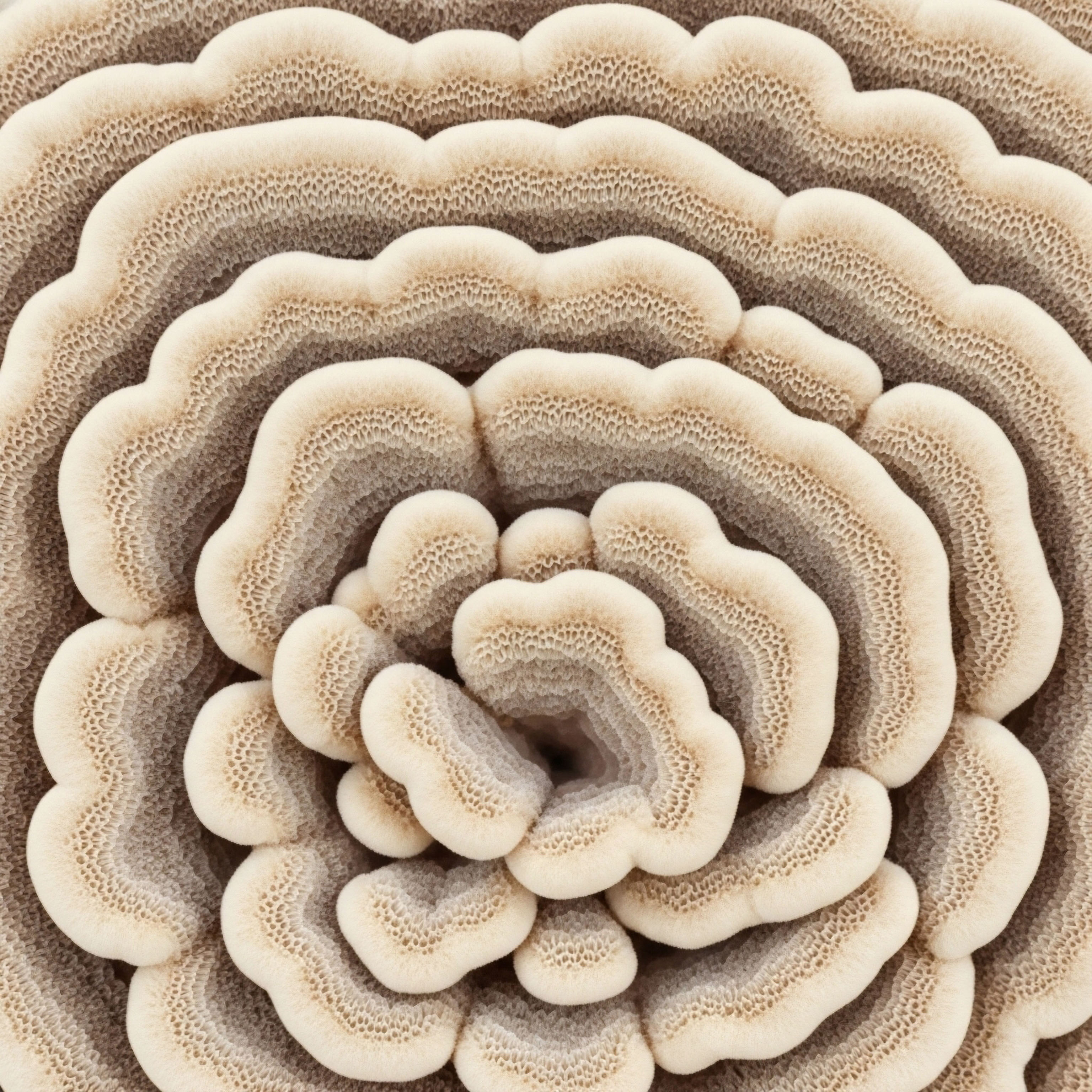

Fundamentals
You may have noticed a change in the texture of your hair, a widening part, or more strands than usual in your brush. It is a deeply personal and often disquieting experience. This process is frequently driven by an inherited trait, a specific sensitivity within your hair follicles to hormones that have circulated in your body your entire life.
Your body is not failing; it is following a precise genetic blueprint related to how it responds to androgens, the family of hormones that includes testosterone. The journey of your hair’s health over a lifetime is directly connected to this inherited sensitivity, a biological story written in your DNA long before any visible changes appeared.
The core of this experience lies within the androgen receptor (AR), a protein present in cells throughout your body, including those in your hair follicles. Think of the AR as a specialized docking station. When an androgen, specifically a potent form called dihydrotestosterone (DHT), binds to this receptor, it sends a signal to the cell.
For individuals with a genetic predisposition to hair loss, the androgen receptors in their scalp follicles are exceptionally receptive to these signals. This heightened sensitivity is the central factor that initiates a cascade of long-term changes to hair structure and growth.
The inherited sensitivity of hair follicles to androgens is the primary driver of patterned hair loss.
This genetic instruction is passed down through families, with the gene for the androgen receptor located on the X chromosome. This explains why the pattern of hair loss in your maternal line can sometimes offer clues to your own predisposition. The presence of specific variations in this gene makes the follicles overly responsive to normal levels of androgens. It is this genetic reality that sets the stage for the long-term effects on your hair’s vitality and appearance.

The Process of Follicular Miniaturization
The persistent signaling from DHT in these sensitive follicles triggers a gradual process known as miniaturization. This is the biological mechanism behind the visible thinning of hair. Each hair on your head cycles through phases of growth (anagen), transition (catagen), and rest (telogen).
In follicles with high androgen sensitivity, DHT’s influence systematically shortens the anagen, or growth, phase. With each successive cycle, the hair produced is shorter, finer, and less pigmented. Over years and decades, a thick, terminal hair can be progressively replaced by a tiny, vellus-like hair, until the follicle may eventually cease producing hair altogether. This is a slow, predictable transformation, a direct consequence of the genetic code being expressed within the scalp’s unique hormonal environment.

Understanding the Hormonal Component
It is important to recognize that androgenetic alopecia is not caused by having excessive levels of testosterone. Rather, it is the result of a normal amount of testosterone being converted into DHT and interacting with hypersensitive follicles. The enzyme responsible for this conversion is called 5-alpha-reductase.
Higher levels of this enzyme in scalp tissue can contribute to the process, but the fundamental issue remains the follicle’s genetic response to the DHT that is produced. This explains why individuals can have completely normal hormone panels yet still experience significant hair loss. The long-term trajectory of hair health in this context is defined by this localized, genetically determined hormonal interaction, a process that unfolds gradually over a lifetime.


Intermediate
Understanding the long-term trajectory of androgen-sensitive hair requires moving beyond the fact of genetic predisposition and into the specific cellular and molecular dialogues occurring within the follicle. The persistent interaction between dihydrotestosterone (DHT) and a genetically sensitized androgen receptor (AR) initiates a series of downstream events that collectively alter the follicle’s structure and function permanently. This is a story of signaling cascades, cellular stress, and a programmed response that leads to the progressive shutdown of hair production.
The dermal papilla, a cluster of specialized cells at the base of the hair follicle, is the primary site of androgen action. In individuals with androgenetic alopecia, dermal papilla cells (DPCs) from balding areas of the scalp contain higher concentrations of androgen receptors compared to DPCs from non-balding areas.
When DHT binds to these abundant receptors, the resulting complex alters the expression of various genes, changing the cocktail of growth factors that the dermal papilla secretes. These signaling molecules are meant to orchestrate the hair growth cycle, and their dysregulation is a key step in the miniaturization process.
The binding of DHT to sensitized androgen receptors in the dermal papilla alters the production of key growth factors, disrupting the hair cycle.

The Role of Cellular Senescence
One of the most significant long-term consequences of sustained androgen signaling in sensitive follicles is the induction of premature cellular senescence. Senescence is a state of irreversible growth arrest in a cell. Research indicates that androgen/AR signaling accelerates this process in the dermal papilla cells of individuals with androgenetic alopecia.
This is not simply a passive aging process; it is an active, stress-induced state. The constant stimulation by DHT appears to cause DNA damage within these cells. In response to this damage, cells upregulate specific proteins, such as p16INK4a, which effectively puts the brakes on cell division.
A senescent dermal papilla is unable to properly support the robust growth of a hair follicle, leading to a smaller papilla and, consequently, a smaller, finer hair shaft. This helps explain why, in advanced stages, the process of miniaturization becomes difficult to reverse; the follicle’s control center has entered a state of permanent retirement.

What Are the Long-Term Consequences of Follicular Inflammation?
Chronic, low-grade inflammation is another critical factor in the long-term prognosis of androgen-sensitive hair. The processes initiated by DHT can trigger an inflammatory response around the follicle. This micro-inflammation contributes to the breakdown of the surrounding connective tissue, leading to perifollicular fibrosis.
This scarring further constricts the follicle and can disrupt the local population of stem cells responsible for regenerating the hair during each new anagen phase. Over many years, this combination of cellular senescence and fibrotic tissue remodeling creates an environment that is inhospitable to healthy hair growth, cementing the follicle’s miniaturized state.

Comparing Androgen Action in Different Follicles
The varying effects of androgens on hair in different parts of the body highlight the specificity of genetic programming. The same DHT molecule that triggers miniaturization on the scalp is responsible for stimulating the growth of thick terminal hair in the beard and on the chest. The table below illustrates these divergent outcomes, which are dictated by the local programming of the follicle’s androgen receptors and the downstream signals they generate.
| Follicle Location | Androgen Receptor Sensitivity | Response to DHT | Long-Term Outcome |
|---|---|---|---|
| Scalp (Vertex/Frontal) | High (in genetically predisposed individuals) | Shortens anagen phase, promotes miniaturization | Progressive thinning (Androgenetic Alopecia) |
| Beard | High | Prolongs anagen phase, promotes growth of thick, terminal hair | Maturation and growth during and after puberty |
| Occipital Scalp (Back of Head) | Low | Minimal response | Hair growth is largely preserved |
This differential response underscores that the long-term health of hair is governed by local tissue sensitivity, a direct output of genetic expression. It is the inherited nature of the receptor, not the hormone itself, that dictates the follicle’s ultimate fate.


Academic
A sophisticated analysis of the long-term effects of androgen sensitivity on hair health necessitates a deep examination of the molecular genetics of the androgen receptor (AR) gene and the subsequent pathological pathways it initiates. The clinical presentation of androgenetic alopecia (AGA) is the macroscopic result of altered gene expression within the dermal papilla cells (DPCs).
The AR gene, located at Xq11-q12, is a primary determinant, with specific polymorphisms creating a receptor that is hyper-responsive to dihydrotestosterone (DHT). This heightened sensitivity is the fulcrum upon which the entire pathophysiology of hair follicle miniaturization pivots.
The genetic architecture of AGA is complex and polygenic, but studies confirm that variations in the AR gene are a major contributor, accounting for a significant portion of the genetic risk. One area of intense investigation involves the StuI restriction fragment length polymorphism and the polyglycine (GGN) repeat in exon 1 of the AR gene.
Shorter GGN repeat lengths have been correlated with increased transcriptional activity of the receptor, meaning it is more efficient at turning on target genes in response to androgen binding. This increased efficiency translates into an amplified biological response to normal circulating levels of DHT, providing a molecular basis for the concept of “sensitivity.”

Dysregulation of Paracrine Signaling Pathways
The hyper-activated androgen/AR complex in DPCs does not directly cause the hair follicle to shrink. Instead, it functions as a master regulator, altering the transcription of genes that encode for paracrine factors ∞ signaling molecules that DPCs secrete to communicate with neighboring keratinocytes in the hair matrix. This altered secretome is the true effector of miniaturization.
Several key signaling pathways are implicated:
- Transforming Growth Factor-beta (TGF-β) ∞ DHT-stimulated DPCs are known to upregulate TGF-β1 and TGF-β2. These are potent catagen-inducing cytokines. Elevated levels of TGF-β effectively push the hair follicle out of its anagen (growth) phase prematurely and inhibit the proliferation of follicular keratinocytes.
- Dickkopf-1 (DKK1) ∞ DKK1 is another critical downstream factor. It is a potent inhibitor of the Wnt/β-catenin signaling pathway, which is essential for inducing and maintaining the anagen phase. By secreting DKK1, androgen-stimulated DPCs actively suppress one of the most important pro-growth pathways in the follicle, leading to apoptosis of outer root sheath cells.
- Insulin-like Growth Factor-1 (IGF-1) ∞ Conversely, IGF-1 is a pro-anagen factor, and its production appears to be suppressed in balding DPCs. The androgen/AR complex may directly or indirectly lead to reduced IGF-1 signaling, further tipping the balance away from growth and toward regression.
The primary long-term molecular effect of androgen sensitivity is the sustained dysregulation of the dermal papilla’s secretome, creating a microenvironment that actively suppresses hair growth.

Cellular Energetics and Oxidative Stress
The long-term consequences extend to the bioenergetic status of the follicle. The premature senescence observed in balding DPCs is intrinsically linked to mitochondrial dysfunction and oxidative stress. Androgen/AR signaling has been shown to induce DNA damage, likely through the generation of reactive oxygen species (ROS). This chronic oxidative stress contributes to the senescence phenotype and depletes the follicle’s regenerative capacity over time. The table below outlines the progression from genetic trait to cellular pathology.
| Molecular Event | Cellular Consequence | Follicular Outcome | Clinical Manifestation |
|---|---|---|---|
| AR Gene Polymorphism (e.g. short GGN repeat) | Increased AR transcriptional activity | Heightened sensitivity to DHT | Genetic predisposition to AGA |
| Sustained DHT-AR Binding | Upregulation of TGF-β and DKK1; DNA damage | Premature catagen induction; Wnt pathway inhibition | Shortened anagen cycle |
| Chronic Paracrine Dysregulation | Induction of premature senescence in DPCs; perifollicular fibrosis | Failure to support keratinocyte proliferation; stem cell niche disruption | Progressive hair shaft thinning (miniaturization) |
| Cumulative Cellular Damage | Irreversible growth arrest of DPCs | Inactive follicle | Visible hair loss |

How Does Epigenetics Influence Androgen Sensitivity?
Beyond the genetic code itself, epigenetic modifications play a crucial role. DNA methylation patterns in the promoter region of the AR gene can influence its expression. Studies have found that hair follicles from non-balding occipital scalp have higher levels of AR gene promoter methylation compared to follicles from the balding vertex.
This methylation acts as a silencing mechanism, reducing the number of androgen receptors produced and thereby protecting the follicle from DHT’s effects. This suggests that long-term hair health is not only determined by the inherited AR sequence but also by the epigenetic regulation that controls its expression in different scalp regions.

References
- Ellis, J. A. Stebbing, M. & Harrap, S. B. (2005). Genetic variation in the human androgen receptor gene is the major determinant of common early-onset androgenetic alopecia. The American Journal of Human Genetics, 77 (1), 140 ∞ 148.
- Inui, S. & Itami, S. (2013). Androgen actions on the human hair follicle ∞ perspectives. Experimental Dermatology, 22 (3), 168-171.
- Valia, A. R. (2016). Genetic and molecular aspects of androgenetic alopecia. Indian Journal of Dermatology, Venereology, and Leprology, 82 (5), 499.
- Chen, X. Liu, B. & Yu, M. (2020). Androgens and androgen receptor action in skin and hair follicles. Frontiers in Medicine, 7, 109.
- Yang, Y. C. Fu, H. C. Wu, C. Y. Wei, K. T. Huang, K. E. & Kang, H. Y. (2013). Androgen receptor accelerates premature senescence of human dermal papilla cells in association with DNA damage. PloS one, 8 (11), e79434.

Reflection

Charting Your Biological Narrative
The information presented here provides a map of the biological processes that may be unfolding on your scalp. This knowledge transforms the experience from one of passive loss to one of active understanding. Recognizing that your body is executing a precise, inherited script can be a powerful shift in perspective.
The journey of your hair’s health is a part of your unique physiological story. Contemplating this intricate connection between your genes, your hormones, and your cellular responses is the first step. The path forward involves deciding how you wish to engage with this personal, biological narrative, armed with a deeper comprehension of the underlying mechanisms at play.



